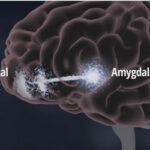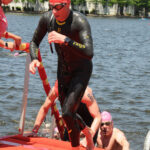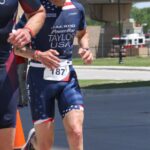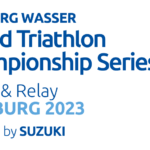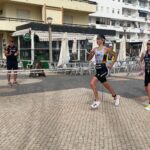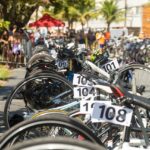On the day of a match, the time you spend before your match is the most crucial period of match preparation. All of the hours of practice you spend on the courts may go for naught if you do not use your pre-match time wisely. What you think, feel, and do before a match will dictate how well you play in the match. This pre-match period should ensure that you are physically and mentally ready to performance your best consistently. All of your energy must be effectively directed toward achieving Prime Tennis.
Prime Tennis is a concept I developed in reaction to my dislike of the phrase, peak performance, which is widely used by sport psychologist, coaches, and players. I see two things inherently wrong with peak performance. First, a peak is by nature very narrow, meaning that a high level of performance can not last long. Second, an inevitable part of a peak is the accompanying valley. So peak performance may mean one or two great matches, but also more average or poor ones.
In contrast, Prime Tennis denotes a consistently high level of performance across the year. Prime Tennis then should be your goal. To achieve Prime Tennis, you must do three things before a match: (1) Prepare your equipment; (2) Warm up your body completely and move toward prime intensity; and (3) Have prime confidence and focus. You can ensure this total preparation by actively taking control of your time and space before a match.
Key Pre-Match Factors
Tournament site.
Where you do your pre-match preparation can have an significant impact on your match readiness, particularly in how it affects your match focus. Some players are easily distracted by all of the activity in and around the tournament site. The competitors, officials, and others can draw your focus away from your preparation and putting on your “match face,” resulting in inadequate readiness and poor match performance. If this describes you, it is important for you to get away from this hub of activity and move off by yourself. By doing so, you can focus on what you need to in order to get ready.
Other players are focused too inwardly, too aware of their thoughts, emotions, and how their body feels. This self-absorption usually results in negative thinking, increased anxiety, poor match focus, and subpar performance. If this describes you, it is best for you to stay around the tournament site activity. This draws your narrow focus outside yourself and, at the same time, allows you to focus sufficiently on your pre-match preparation.
Who to Interact With? Another critical influence on your pre-match readiness is who you interact with prior to the start of your match. You should only be around people who will assist you in your preparation including coaches, family, and friends who help you become totally ready. You should actively avoid anyone who interferes with this process including chatty competitors, officials giving unwanted match information, and media.
In sum, specify what you need to do to be totally prepared to play your best, decide where you can best accomplish your preparation, and identify who can assist and who will interfere with your preparation. With this information, you can develop an effective pre-match routine to ensure total preparation and Prime Tennis.
Pre-match routines.
Why Pre-Match Routines? Routines have many benefits to your pre-match preparation. They guarantee completion of every important aspect of match preparation. Routines build physical, mental, and emotional consistency, which will result in more competitive consistency. They enhance familiarity of competitive situations and decrease the likelihood of unexpected things occurring. Routines increase feelings of control, thereby raising confidence and reducing anxiety. Regardless of the importance of the match, by using a well-practiced routine, you will condition your mind and body into feeling that this is just another match.
Routines vs. rituals.
The goal of routines is to totally prepare you for your match. Everything done in a routine serves a specific function in preparing yourself. Routines are flexible; adjustments can be made to adapt to the situation, for example, a delay at the start of a match due to a long prior match. So you control routines. In contrast, rituals control you. Rituals involve anything that does not have a specific purpose in match preparation. Rituals are inflexible and superstitious. Rituals must be done or you will not believe that you can play well. Seek out routines and avoid rituals!
Prime tennis funnel.
A pre-match routine acts as a funnel, which involves a narrowing of effort, energy, and focus as you approach the start of the match. Each step closer to the match should lead you to that unique state of readiness in which you are physically, mentally, and emotionally primed to play your best. What will emerge from this funnel is Prime Tennis.
Components of a pre-match routine.
Your pre-match routine should comprise everything that you need to do to be totally prepared for your match. This includes meals (e.g., carbo loading), match strategy (e.g., use serve and volley game), equipment (e.g., strings and grips properly prepared), physical warm-up (e.g., run, stretch, stroke warm-up, adjust intensity), and mental preparation (e.g., mental imagery, positive thinking, match focus).
Developing a pre-match routine.
Though the above factors are common to most if not all pre-match routines, there is no one ideal routine that works for everyone. In other words, routines are very personal. They should reflect your own individual personality and style.
In order to develop an effective personalized pre-match routine, you can use the following guidelines. First, write down what you need to do before a match to be totally prepared. Second, using your knowledge of pre-match activities and the tournament site, order your needs chronologically leading up to the start of the match and specify where each step of your routine can be best accomplished. Third, experiment with your routine at subsequent tournaments. You will probably have to fine tune it until you find a routine that you are completely comfortable with. Finally, routines only have value if used consistently. If you ask top players such as Steffi Graf and Pete Sampras about their routines, most will describe one that they have been using for years. So make a routine a part of your match preparation and it will assist you in achieving your own Prime Tennis.
Between-Point Routines
As with pre-match preparation, the 25 seconds you spend between points will often determine how you play during points. So you should use that time to ensure that you are maximally ready to play your best. This can be best accomplished by developed an effective between-points routine that includes everything you need to do that will lead to Prime Tennis. This routine can best be organized with what I call the 3 R’s: Rest, Refocus, Recharge.
Rest.
Tennis can be physically demanding. Long points can leave you breathing heavily and your muscles fatigued. So immediately after the conclusion of a point, you must take steps to rest and recover for the next point. To do this, turn your back to the court, take several controlled deep breaths, and relax your muscles, particularly in your neck and shoulders. This step should take 5-10 seconds.
Refocus.
There is a tendency for many players to dwell on the previous point, particularly if important and poorly played. Maintaining this past focus is unproductive because the previous point can’t be changed and focusing on it will not help you play the next point. So this step of the 3 R’s should be directed toward focusing on what you need to do to play the next point well. First, direct your focus inward, taking your mind off your opponent and the court surroundings. Second, briefly examine the last point and learn from it. For example, you may have just gotten passed by a cross-court forehand for the fourth time. Third, consider your strategy for the upcoming point. Finally, decide on your strategy for the next point, for instance, by hitting an approach shot to your opponent’s backhand. Most importantly, as you walk to the line to serve or receive, you should know exactly what you want to do on that point. This step should take about 10 seconds.
Recharge.
During the previous 15-20 seconds, your body has had a decrease in intensity and your focus is narrow and inwardly directly. As you move to begin the next point, you need to do two things. First, increase your intensity to get your adrenaline flowing and the energy you need to play well. This be done by moving, jumping around, using high-energy self-talk (e.g., “let’s go” and “hustle”) and positive body language (e.g., pump your fist and slap your thigh). Next, redirect your focus and point strategy outward onto your opponent and the game situation.
When you come to the line to serve and receive you should be mentally and physically ready to play the next point as well as you can.
As with pre-match routines, between-point routines are also personal. How you accomplish the 3 R’s will depend on your individual personality and style. You can apply the guidelines I described above for pre-match routines to your between-point routine to develop one that works best for you.
By developing pre-match and between-point routines, you will be better prepared to begin a match and to start every point. These routines will ingrain a consistent pattern of skills and habits that will result in a consistently higher level of play, that is, you will more often play Prime Tennis.

